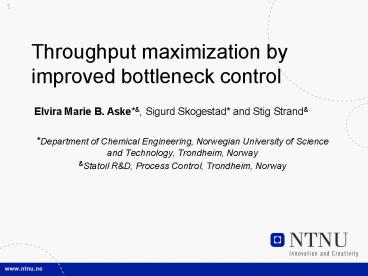Throughput maximization by improved bottleneck control PowerPoint PPT Presentation
1 / 15
Title: Throughput maximization by improved bottleneck control
1
Throughput maximization by improved bottleneck
control
- Elvira Marie B. Aske, Sigurd Skogestad and
Stig Strand - Department of Chemical Engineering, Norwegian
University of Science and Technology, Trondheim,
Norway - Statoil RD, Process Control, Trondheim, Norway
2
Outline
- Modes of optimal operation
- Maximum throughput
- Throughput manipulator (TPM)
- Max-flow min-cut theorem
- Realizing maximum throughput
- Single-loop
- MPC
- Back off
- Conclusions
3
Depending on marked conditions Two main modes of
optimal operation
- Mode 1. Given throughput (nominal case)
- Given feed or product rate
- Maximize efficiency Unconstrained
optimum (trade-off) - Mode 2. Max/Optimum throughput
- Throughput is a degree of freedom good
product prices - 2a) Maximum throughput
- Increase throughput until constraints give
infeasible operation - Constrained optimum - identify active
constraints (bottleneck!) - 2b) Optimized throughput
- Increase throughput until further increase is
uneconomical - Unconstrained optimum
4
Mode 2a Maximum throughput
- Typical profit function
- Feed flows are set in proportion to F and assume
constant efficiencies - Leads to
- Maximize profit ? Maximize throughput F
5
Throughput manipulator (TPM)
Buckley (1964). Techniques of Process
Control Price, Lyman and Georgakis (1994).
Throughput manipulation in plantwide control
structures. Ind. Eng. Chem. Res. 33, 11971207.
6
From network theory Max-flow min-cut theorem
Maximum flow through the network is equal to the
capacity of the minimal cut (Ford and Fulkerson,
1962)
7
Bottleneck
- Maximum throughput achieved by maximizing the
flow through the bottleneck - If the flow for some time is not at its maximum
through the bottleneck, then this loss can never
be recovered - ? Maximum throughput requires tight control of
the bottleneck unit
8
Rules for achieving maximum throughput
- Maximize flow F through bottleneck at all times
- Use TPM for control of bottleneck unit
- Locate TPM to achieve tight control at bottleneck
- Back off usually needed to ensure feasibility
dynamically
Fmax
F
Fset point
Back off
Time
9
Realize maximum throughput
Best result (minimize back-off) if TPM
permanently is moved to bottleneck unit
Max bottleneck
Skogestad (2004) Control structure design for
complete chemical plants Comp. Chem. Eng 28
p.219-234
10
Realize maximum throughput in more complex cases
- Bottleneck moves
- Multiple feeds and crossovers
- Proposed solution Coordinator MPC
- Estimate of remaining capacity in each unit is
obtained from local MPCs - Coordinator MPC manipulate TPMs ( crossovers) to
maximize flow through bottlenecks
Aske et al. (2007) Coordinator MPC for
maximizing plant throughput Submitted to Comp.
Chem. Eng
11
Coordinator MPC
- maximize throughput (CV with high, unreachable
set point with lower priority) - TPMs as MVs -
keep columns within their capacity (CV
constraints) - disturbances moves the bottlenecks
CV
CV
CV
CV
MV
MV
MV
CV
MV
CV
CV
CV
MV
CV
MV
CV
12
Back off loss (in throughput)
- Back off can be reduced by
- Improved control (to some extent)
- Limited by network dynamics from TPM to
bottleneck - Obtain TPM closer to bottleneck
- Move TPM (Change in base control)
- Add buffer tanks to get dynamic TPMs (Design
change) - or use existing buffer volumes
- Estimate back off to find economic incentive
- Worst case amplification
13
Example estimation of back off
- Compare TPM at feed and at bottleneck
- Feedback controller K tuned by Skogestads tuning
rules, tc3?eff - Disturbance rejection as function of frequency
14
Back off as a function of frequency
- Peak unavoidable
- Effect of disturbances reduced
15
Conclusions
- Tighter bottleneck control can reduce back off
- TPM should be used for control of the bottleneck
unit to obtain maximum flow - Bottleneck fixed ?single-loop control sufficient
- Bottleneck moves ? multivariable control
- Consider moving/adding TPM if back off is large

